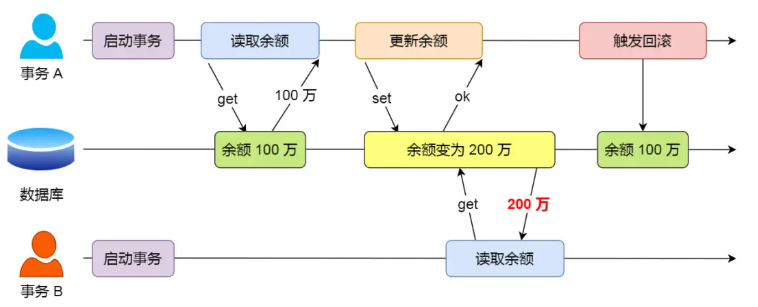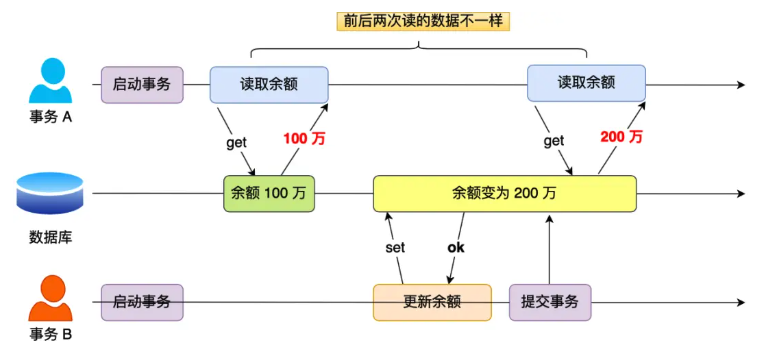Transactional
1. What concurrency-related issues might MySQL encounter?
- MySQL server allows multiple client connections, meaning it handles multiple transactions simultaneously.
- Issue like dirty read, non-repeatable read, lost update, and phantom read may occur.
Dirty Read

- If a transaction reads data modified by another uncommitted transaction, it means a dirty read has occurred.
- Potentially leading to inconsistent or incorrect data.
- Because Transaction A is uncommitted, it may roll back at any time. If Transaction A rolls back in the scenario described, the data read by Transaction B becomes outdated. This phenomenon is called a dirty read.
Non-Repeatable Read

- Scope: Specific row
- If a transaction reads the same data multiple times and the data differs between reads, it means a non-repeatable read has occurred.
Phantom Read

- Scope: Set of rows
- If a transaction queries the "number of records" meeting a certain condition multiple times and the number of records differs between queries, it means a phantom read has occurred.
- Transaction A starts by querying the database for accounts with a balance greater than 1 million and finds 5 records. Transaction B, using the same search condition, also queries and finds 5 records.
- Next, Transaction A inserts a new account with a balance exceeding 1 million and commits the transaction, increasing the number of accounts with a balance over 1 million to 6.
- Then, Transaction B queries again for accounts with a balance greater than 1 million and now finds 6 records, which differs from the previous query's result. This creates the illusion of a "phantom" change, and this phenomenon is called a phantom read.
2. What scenario can't tolerate Dirty Read?
- Banking Systems: Financial transactions demand precise and consistent data. A dirty read could result in incorrect balance information, leading to errors in account management or customer-facing applications.
- Inventory Management Systems: Accurate stock levels are critical for operational efficiency. Dirty reads could cause incorrect inventory counts, leading to overselling or stockouts.
- Online Order Systems: Order processing requires consistent state information. A dirty read could display incorrect order statuses to customers, causing confusion or incorrect order fulfillment.
3. How MySQL handles concurrency issues?
Locking Mechanisms
- Various locks: row-level locks, table-level locks, and page-level locks.
- By locking data during read or write operations, these mechanisms ensure that only one operation can access or modify the data at a time.
Transaction Isolation Levels
- Multiple isolation levels: Read Uncommitted, Read Committed, Repeatable Read, Serializable.
MVCC (Multi-Version Concurrency Control)
- Uses MVCC to manage concurrent access. It maintains different versions of data in the database to achieve isolation between transactions.
- When reading data, MySQL selects the appropriate data version based on the transaction’s isolation level, ensuring data consistency.
4. What are the transaction isolation levels?
-
Listed from lowest to highest:
-
Read Uncommitted
- A transaction can read uncommitted data from other transactions.
- Leads to dirty reads, non-repeatable reads, and phantom reads.
-
Read Committed
- A transaction can only read data that has been committed by other transactions.
- Prevent dirty reads, but may still have non-repeatable reads and phantom reads.
-
Repeatable Read
- Multiple reads of the same data within the same transaction yield consistent results
- Prevent dirty reads and non-rearepeatable reads, but may still have phantom reads.
- Default isolation level for MySQL's InnoDB engine.
-
Serializable
- Transactions are executed completely sequentially.
- Prevents dirty reads, non-repeatable reads, and phantom reads.
- But with the lowest concurrency performance.
-
-
Specific example to illustrate the four isolation levels:
- Two concurrent transactions are involved: Transaction A is only responsible for querying the balance, while Transaction B changes the balance to 2 million. Below is the behavior of the two transactions executed in chronological order:

- The balance queried during transaction A execution will be different at different isolation levels.
- Read Uncommitted: V1, V2 and V3 are 2million.
- Read Committed: V1 is 1million, V2 and V3 are 2million.
- Repeatable Read: V1 and V2 are 1million, V3 is 2million.
- Serializable: V1, V2 and V3 are 1million.
- Transaction B is blocked because Transaction A is still running.
- Two concurrent transactions are involved: Transaction A is only responsible for querying the balance, while Transaction B changes the balance to 2 million. Below is the behavior of the two transactions executed in chronological order:
5. How above transaction isolation levels are achieved in MySQL?
- Read Uncommitted: Since the data modified by the uncommitted transaction can be read, so just read the latest data directly.
- Serializable: By adding read/write locks.
- Read Committed && Repeatable Read:
- Implemented through Read View.
- Difference: Read View is created at different times
- Read View: A snapshot of data at a specific time.
- Read Committed: Before the execution of statement.
- Repeatable Read: When the transaction starts, then use this Read View throughout the transaction.
- Implemented through